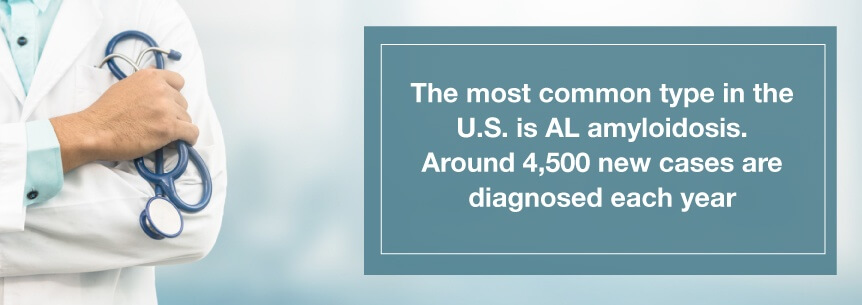Chances are you’ve heard how medical cannabis can help with an array of symptoms from inflammation to pain and nausea. Research now suggests medical marijuana may help treat amyloidosis symptoms as well.
Amyloidosis is a health problem where amyloid, an abnormal protein generated in your bone marrow, builds up in your organs and tissues. When this occurs, it affects the amyloid’s shape and function. While amyloidosis doesn’t have a cure, treatments can limit amyloid protein production and manage your symptoms. However, amyloidosis can lead to organ failure and be life-threatening.
Amyloidosis can affect your:
Amyloidosis doesn’t affect the same organs in everyone, either.
Amyloidosis diseases originate in three main ways:
Different forms of amyloid exist. Various proteins can cause amyloid deposits. However, only a few cause major health issues. The form of amyloidosis you have depends on what type of protein it is and where it collects. As amyloid clusters in a group, it can be in several areas of your body simultaneously (systemic) or in only one particular area (localized). In other words, amyloid deposits can collect in one area or throughout your body. All amyloidosis forms have an excessive amount of abnormal protein production.
Three common systemic amyloidosis diseases are:
The most common type in the U.S. is AL amyloidosis. Around 4,500 new cases are diagnosed each year, according to the Amyloidosis Foundation (AF). Generally, individuals who are between the ages 50 to 80 develop it, but there have been cases of individuals in their late 20s receiving a diagnosis as well. Having a bone marrow disorder can cause AL amyloidosis, and around two-thirds of those affected are men.

AA amyloidosis is a reaction to another condition, such as chronic inflammatory disease or long-term infection. Inflammation and infection cause the liver to begin producing serum amyloid A protein (SAA) in high levels. This reaction is normal. However, when inflammation remains for a lengthy period, a small amount of SAA protein — referred to as AA protein, separates from SAA and deposits as AA amyloid in tissues.
Hereditary amyloidosis is one form of systemic amyloidosis that is caused by inheriting a gene mutation. The genetic mutation goes on to produce an irregularly-shaped amyloid protein. These irregular “misfolded” amyloid proteins are then deposited where they cluster in your organs and nerves, building up and potentially harming organ and/or tissue function.
Although you’re born with a gene mutation, typically it’s not until adulthood when harmful deposits occur. Even though every type of hereditary amyloidosis may result in severe complications, some individuals can carry this gene mutation but not show any symptoms of the condition at all. Others might have a few minor health problems. ATTR and Non-TTR are the two primary classifications of hereditary amyloidosis. With ATTR, your body generates a mutant protein, called transthyretin, abbreviated as TTR.
In 1854, Virchow popularized the amyloid name. However, amyloid was described, just not with that term, by those who performed autopsies well before 1854, such as:
In 1842, Rokitansky made the description of the “waxy” liver type of splenomegaly and lardaceous liver consistent with amyloid. Budd did the same in 1845. Both are often given credit for the first amyloid descriptions, even though it was clear the earlier pathologists had already come across this substance.
Until your disease advances, you might not experience any amyloidosis symptoms. When you do experience symptoms, they’ll depend on the organs that are affected.
Some symptoms and signs of amyloidosis might include:
If you are experiencing any of these amyloidosis-related symptoms, see your doctor.
Amyloidosis has potential complications depending on the organs affected by the amyloid deposits. The condition can severely damage your:

You might have social and emotional effects along with physical effects after you receive an amyloidosis diagnosis. These effects might include anger, anxiety or stress. According to a study involving 1,226 AL amyloidosis patients, 46.7 percent reported anxiety, and 37 percent reported depression.
Statistics associated with Amyloidosis include the following:
While currently, there’s no cure for amyloidosis, your doctor can prescribe treatment protocols to slow the amyloid protein development and manage your symptoms. If another condition is causing your amyloidosis, you’ll likely receive a treatment for your underlying condition.
The type of treatment your doctor prescribes depends on the type of amyloidosis you have and the number of organs it affects. Treatment options may include:
1. High-Dose Chemotherapy for AL Amyloidosis
High doses of chemo along with a stem cell transplant could help stop the formation of amyloid if you have primary AL amyloidosis and don’t have more than a couple of major organs harmed. Chemotherapy drugs by themselves can treat those with primary AL amyloidosis.
Side effects of chemotherapy include:
2. Anti-Inflammatory Medications (Steroids) for Secondary (AA) Amyloidosis
Treatment for this type includes strong anti-inflammatory medications (steroids) to tackle the inflammation and to control the underlying condition.
Side effects of steroids include:
With hereditary amyloidosis, a liver transplant might stop the condition. Your doctor may also suggest a kidney or heart transplant.
3. Other Treatment Therapies
You may receive other treatments to manage your symptoms, such as:
Amyloidosis can be fatal, particularly if it is affecting your kidneys or heart. To improve survival, early diagnosis and treatment are key.
The U.S. Office of Rare Diseases (ORD), a division of the National Institutes of Health (NIH), labels amyloidosis as a rare disease. It’s also called an “orphan” disease. Since the U.S. government classifies amyloidosis as a rare disease, it means all forms of the disease combined affect fewer than about 200,000 individuals in the U.S. population.
With continued research, this rare classification could change. Some experts believe a few of the amyloidosis diseases aren’t unusual, but rather are rarely diagnosed. An understanding of the diseases will lead to better treatments with increased research funding. It may also help to raise more general public and medical community awareness — another important factor that can lead to early diagnosis of the disease.
THC prevents amyloid plaque formation. Cannabis and amyloidosis treatment stops B-amyloid peptide aggregation. The cannabinoids in the marijuana plant have immunomodulatory properties that can help with neuroinflammatory diseases. Medical weed’s THC stops cell-mediated immune responses. This cannabinoid is an analgesic and neuroprotector. The CBD in medical pot reduces anxiety, inflammation and nausea.
Medical cannabis for amyloidosis acts as an efficient antiemetic treatment — relieves nausea and vomiting. In fact, it’s even more effective than a lot of pharmaceuticals and doesn’t have the side effects like these drugs. As mentioned above, chemotherapy is one of the first line treatments for amyloidosis and almost always causes nausea and vomiting.
Marijuana and amyloidosis treatment can help with the following amyloidosis symptoms:

If another disease causes amyloidosis, your doctor will treat the underlying condition in an aggressive manner. If caught in time, this may drastically improve your symptoms, or it may slow the disease from getting any worse. While some patients are okay with taking the more traditional pharmaceutical approach to treating amyloidosis, some patients do not respond very well to those treatments. This is where medical marijuana can serve as an exceptional alternative treatment option for this disease.
Medical marijuana can treat amyloidosis in a great variety of ways, all of which are very beneficial to a patient who is suffering. Marijuana serves as an anti-inflammatory and can provide the reduction of any swelling going on within the body.
Marijuana is also great for alleviating sustained nausea during the patient’s everyday routine. Traditional methods of medicine, mainly involving opiates, can cause tough and hard-to-cope side effects, ironically enough like nausea. Marijuana with very high CBD levels has been shown to be capable of reducing pain, inflammation, stomach cramps, nausea, anxiety and arthritis.

Some medical marijuana strains that are ideal for amyloidosis include:
Consuming medical cannabis is a lot different than popping a pill. There are many different consumption methods to receive your marijuana for amyloidosis. Each method comes with its benefits and delivery effects.
Some of the best cannabis consumption methods include:
By experimenting with different methods, you’ll eventually figure out which way works best for you to give you the desired effect. Smoking may not be considered one of the best marijuana consumption methods as the smoke from marijuana contains some of the same chemicals as tobacco. That’s why you should work with your marijuana doctor and experienced cannabis dispensary budtender to find the best ingestion method for you.
Once you’ve researched medical marijuana and have learned more about it, you’ll then need to find a medical cannabis-friendly doctor to provide you with your recommendation, which you need to get before you can begin medical cannabis treatment. Although amyloidosis symptoms can be debilitating, you don’t have to suffer with them. MarijuanaDoctors.com is your one stop to find a doctor and dispensary to start your amyloidosis treatment.
Find A Doctor Find A Dispensary